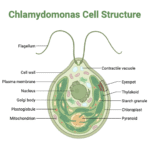How does separase activated and what is its effect?
How does separase activated and what is its effect?
Please login to submit an answer.
Separase is a crucial cysteine protease that plays a vital role in the regulation of the cell cycle, particularly during the transition from metaphase to anaphase. Its primary function is to cleave cohesin, a protein complex that holds sister chromatids together, thereby facilitating their separation and ensuring accurate chromosome segregation during cell division.
The activation of separase is tightly regulated and primarily occurs through the degradation of its inhibitor, securin. During metaphase, securin binds to separase, preventing its proteolytic activity. The anaphase-promoting complex/cyclosome (APC/C) is responsible for the ubiquitination and subsequent proteasomal degradation of securin, which leads to the release and activation of separase (Luo & Tong, 2018; Hellmuth et al., 2020; Meadows & Millar, 2015). This process is essential for the initiation of anaphase, as the cleavage of cohesin by separase allows sister chromatids to move toward opposite poles of the cell (Nasmyth & Oliveira, 2010).
In addition to the role of securin, separase is also regulated by cyclin B1-cyclin-dependent kinase 1 (Cdk1). The binding of Cdk1-cyclin B1 to separase inhibits its activity, ensuring that separase remains inactive until the appropriate time in the cell cycle (Hellmuth et al., 2015). The degradation of cyclin B1 by APC/C also contributes to the activation of separase, as the inactivation of Cdk1 allows separase to function effectively (Konishi et al., 2018). Furthermore, the phosphorylation state of separase itself can influence its activity, with certain phosphorylations promoting its association with Cdk1-cyclin B1 complexes, thereby inhibiting its function until the cell is ready to proceed to anaphase (Yu et al., 2023; Han & Poon, 2013).
The effects of separase activation are profound. Once activated, separase cleaves the kleisin subunit of the cohesin complex, leading to the release of sister chromatids (Luo & Tong, 2018; Nasmyth & Oliveira, 2010). This cleavage is critical for the physical separation of chromatids, allowing them to be pulled toward opposite spindle poles during anaphase (Meadows & Millar, 2015). Additionally, separase has been shown to have non-proteolytic functions, such as inhibiting Cdk1 activity, which further facilitates the transition to anaphase by promoting the movement of chromatids (Shindo et al., 2012).
Moreover, separase’s role extends beyond chromosome segregation; it is also involved in centriole disengagement during mitosis, which is essential for proper centrosome duplication in subsequent cell cycles (Matsuo et al., 2012; Agircan & Schiebel, 2014). The precise regulation of separase is crucial, as its premature activation can lead to aneuploidy, a condition associated with various cancers (Zhang & Pati, 2017; Haass et al., 2012).
In summary, separase is activated through the degradation of securin and the inactivation of Cdk1-cyclin B1, leading to its crucial role in cleaving cohesin and facilitating the separation of sister chromatids. This process is essential for accurate chromosome segregation and the overall fidelity of cell division.
- Share on Facebook
- Share on Twitter
- Share on LinkedIn




